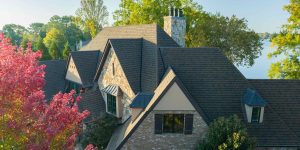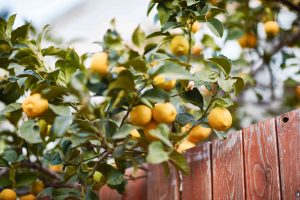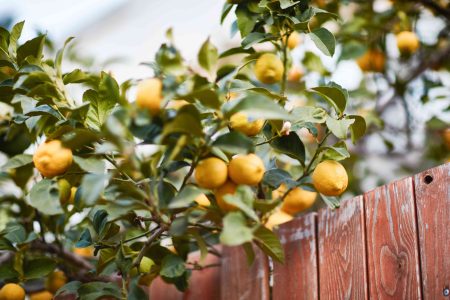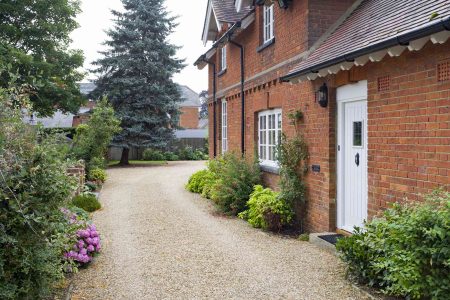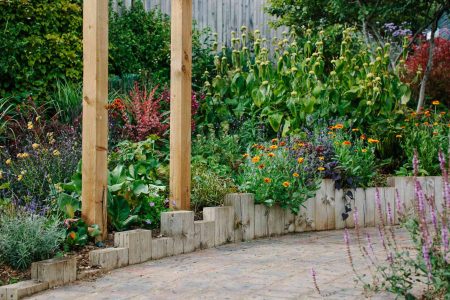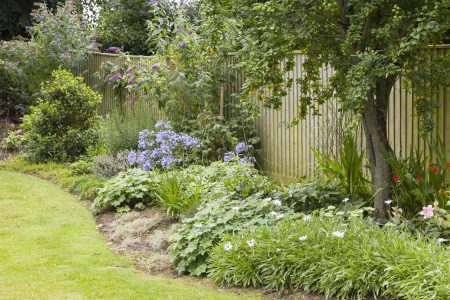Modern landscape design is one of the most popular ways to boost your contemporary home. It’s a practical design choice that isn’t too ornamental and instead embraces understated elements like clean lines and simple details.
To help you seamlessly create the look, we asked the pros what the style is and what their best tips are for creating it.
Meet the Expert
- Cate Singleton is the director of design at Tilly, a landscape design company.
- Bryan Clayton is the CEO and co-founder of GreenPal, a lawn care services app.
- Joe Raboine is the vice president of design at Oldcastle APG.
What Is Modern Landscape Design?
Modern landscape design is predicated on simplicity and clean lines.
“Often these lines reflect or tie into the architecture of the building,” Cate Singleton, the director of design at Tilly, says.
Thus, modern landscape design seeks to bridge a natural connection with architecture. It is a minimalist design approach—think midcentury modern sleekness meets the great outdoors.
Another way to understand modern landscape design is to compare it with more traditional landscaping.
“Whereas traditional landscaping might focus on abundance—lots of colors, varieties of plants, and textures,” Bryan Clayton, CEO and co-founder of GreenPal, says. “Modern design is about restraint and intentionality.”
For example, gardens with modern landscaping designs might focus on standout garden structures, but the garden, itself, should feel uncluttered and simple, allowing the viewer’s eye to rest on a few memorable items.
Elements of Modern Landscape Design
Muted color palette
To blend architecture with landscape, stick to a muted color palette. Clayton recommends greens, grays, and maybe some blues since they blend well with the environment.
Joe Raboine, vice president of design at Oldcastle APG, agrees. “Play into the natural environment rather than offering a burst of bright color,” he says. “Many designers and their clients opt for varying shades of gray.”
One way to keep a muted color palette is to lean into hardscaping.
“Hardscapes that have natural textures, like that of volcanic rock or dried earth, play well with these design concepts,” Singleton says. The colors feel muted and harken to the natural environment at the same time.
Plants With a Purpose
Plants featured in a modern landscape design are not chosen purely for looks, but their function. Plants should be selected because they provide privacy, shade, or a windbreak with a sleek look, Clayton says.
Or they provide the eye with a focal point, Singleton adds. A deep burgundy Japanese maple or a large structural agave would work perfectly. The plants should also require less maintenance overall.
“Think ornamental grasses, structured shrubs, and native plants that require less upkeep,” Singleton says. Other common plant choices for modern landscapes include succulents or bamboo, Raboine says.
Symmetry
Just as minimalism and clean lines reign supreme in modern landscaping design, so does symmetry. For example, decorative hedges or well-groomed shrubs running parallel to each other is one way to create symmetry.
Another way is incorporating geometric shapes, adding to that clean, orderly feel, says Clayton. You can easily achieve this through careful hardscape choices.
“Using porcelain pavers to create a symmetrical walkway is also a popular design choice,” Raboine says. “You can interlay the pieces with grass or turf for a natural look or use gravel or pebbles for more of a contrast.”
Tips for Modern Landscape Design
- Start your modern landscape design with a plan. Clayton recommends thinking of your space as a blank canvas and choosing elements that create a feeling you love when you step into it. “Creating a modern landscape is about crafting an experience as much as it is about planting,” Clayton says.
- Opt for a few high-quality materials and repeat them. This will create a sense of symmetry and cohesion. When it comes to walkways or patios, Raboine suggests thinking about how to modernize the space with repeating textures or porcelain hardscapes.
- Lean into hardscape by using gravel, slate, or polished concrete for paths and patios, Clayton suggests.
- Simplify the color palette.
- Choose structural elements for focal points whether it’s a water feature or a specific plant, Singleton says.
- Keep furniture and decor sleek and simple—less is more.
- Choose modern-style plants like succulents, Raboine says.
Read the full article here



